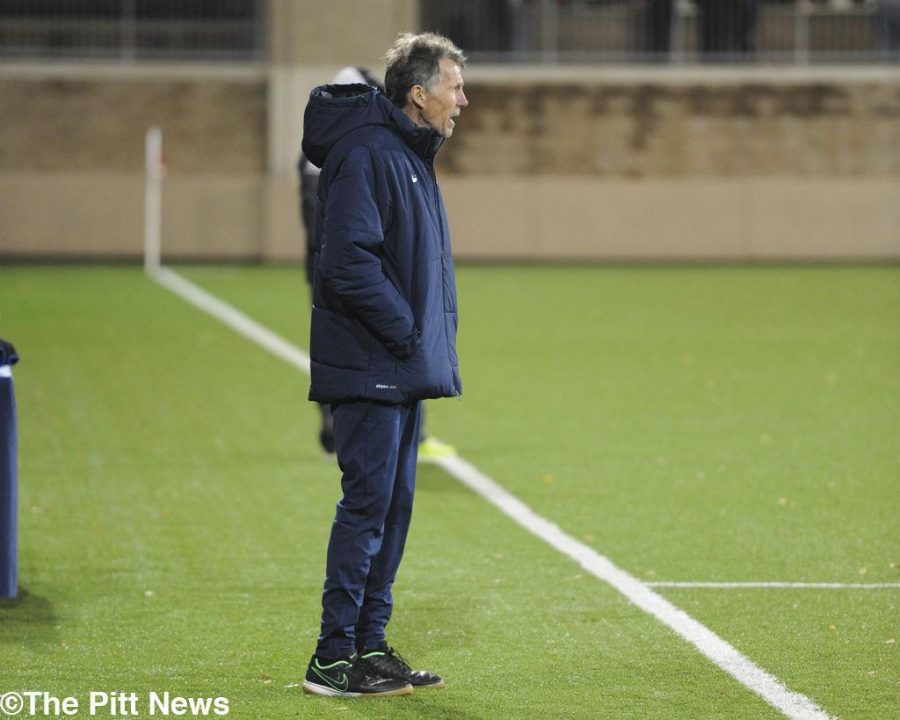Varsity, club, intramural soccer thrive at Pitt
January 21, 2015
Allison Combs looks contemplatively at the grass. Her thoughts whirl as she tries to focus her eyes beyond the ground in front of her. She inhales, steps back and lets it fly. The ball goes soaring through the air.
Rewind to 1863, and see the same scene unfolding: the game of soccer.
Although the idea of kicking a ball through the dirt has rolled around since Christopher Columbus, it did not reach America until the 1870s, when it was brought over by immigrants coming through Ellis Island.
Today, more than 13 million Americans play soccer, and it has become the third-most played sport in the country, behind basketball and baseball.
On college campuses, the game’s national success is mimicked on our smaller fields, as more Pitt students take the soccer pitch. From varsity level teams to club sports and intramural leagues, students have several ways to get in on the action.
Pitt’s long history of varsity soccer began with the men’s team in 1951, while the women’s team started kicking in 1996. The men’s team began as a non-varsity club sport but, three years later, the University elevated the team to varsity level, gaining funding for scholarships in 1961.
Combs, a sophomore communication science and disorders major, took the field as a member of “sorority soccer.” The Student Affairs Intramurals and Recreations Department heads this intramural league. According to Combs, the intramural league includes several different subsections, including sororities, fraternities, dormitory floors and other campus clubs. Members of different organizations sign up based on with whom they associate. For example, members of a sorority sign up for a playing division containing other sororities.
Each subsection includes four to seven teams that compete against each other throughout the six-week season. Each team must have six players registered, but they are allowed to have only five players if one or both teams ever cannot field enough players for a full team. The players usually don’t have assigned positions as there are no coaches, and the roster ultimately depends on who is available each night.
The 40-minute games — plus a five-minute halftime — take place at the Cost Sports Center.
On a different field, things are a bit more intense, and soccer balls fly toward the net, pummeling the keeper. Feet clad in spiky cleats run the length of the field performing exhausting drills and exercises.
These feet belong to sweat-drenched players of the Pitt men’s soccer team.
“Practices are very hard,” head coach Joe Luxbacher said. “But in a game, players make mistakes when they get tired, so we try to prepare [the players] for the environment that they are going to experience in the game.”
The team practices three times a week for 90 minutes, constantly moving from one drill to the next. They must remain in motion, as soccer players average running more than seven miles in a game, according to the research group STATS.
A club team at Pitt is run in a similar fashion to the varsity teams. It holds tryouts, competes in games and has strenuous practices.
The coaches recruit most varsity players to join the soccer team, but some players “walk on” to the team, meaning that they contact the coach and try out without being recruited. Luxbacher said the varsity team has had several walk-ons, often with great success.
Like the varsity team,the club soccer team at Pitt is selective in choosing its players, and takes the competition seriously. Intramural leagues accept any willing participants until the roster fills up.
For all teams, with game day comes more pressure, more noise and more distractions than a secluded practice field. Most of this comes from the cheering audience.
“A loud, supportive crowd helps the players, but you still have to play the game,” Luxbacher said.
For Ryan Hulings, a member of the Riverhounds — the Pittsburgh professional soccer team — being on the field means more than just playing a game.
“Sports are entertainment. Whenever you have a chance to perform, you have to get out there and do it,” Hulings said.
Hulings and Luxbacher have noticed a link between the play on the field and the reaction off of it.
“One sort of fuels the other. If it’s an exciting game, the crowd gets into it, and if the crowd gets into it, it fuels the game, too. Its a two-way street,” Luxbacher said.
Jessica Weinreich, a freshman occupational therapy major participating in the sorority soccer league, said that the audience fuels her motivation as well.
“I like when there is an audience,” she said. “It makes me work harder because it shows me why I am there and that I am representing my sorority.”
Still, games are fierce, and sorority girls play to win.
“The games get somewhat competitive at times, especially when we are in a draw and it is getting close to the end of the game,” Weinreich said. “That atmosphere and competitiveness definitely make it more fun.”
While soccer intramurals are generally more relaxed, club teams gravitate to the intense nature that varsity sports provide.
For Weinreich, intramurals were the right level.
“I used to play a high level of soccer when I was younger,” she said. “There was a lot more pressure to do well and not make mistakes because winning was pretty important. [In intramurals,] its nice not to have to impress a coach or fear that I will be taken out of the game because of a mistake.”
Each team has different rules, different guidelines and different players; however, as Hulings said, the game is always the same. From a dirt field to a crowded stadium, soccer is making its rounds.



